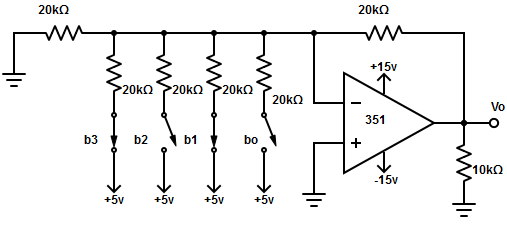1. Express the output voltage of digital to analog converter?
A. Vo =KVFS(d12-1+d22-2+….dn2-n)
B. Vo =VFS/k(d12-1+d22-2+….dn2-n)
C. Vo =VFS(d12-1+d22-2+….dn2-n)
D. Vo =K(d12-1+d22-2+….dn2-n)
2. Why the switches used in weighted resistor DAC are of single pole double throw (SPDT) type?
A. To connect the resistance to reference voltage
B. To connect the resistance to ground
C. To connect the resistance to either reference voltage or ground
D. To connect the resistance to the output
3. Determine the output current for an n-bit weighted resistor DAC?
A. (VR/R )× (do/2 +d1/22 + ……dn/2n)
B. (VR/R )× (d1/21 +d2/22 + ……dn/2n)
C. (VR/R )× (d02/2 +d12/22 + ……dn2/2n)
D. None of the mentioned
4. In a D-A converter with a binary-weighted resistor, the desired step size can be obtained by
A. Selecting proper value of VFS
B. Selecting proper value of R
C. Selecting proper value of RF
D. All of the mentioned
5. Determine the Full-scale output in an 8-bit DAC for the 0-15v range?
A. Full-scale output=15.1v
B. Full scale output=15.2v
C. Full scale output=14.5v
D. Full scale output=14.94v
6. Pick out the incorrect statement “In a 3-bit weighted resistor DAC”
A. Although the op-amp is connected in inverting mode, it can also be connected in non-inverting mode
B. The op-amp simply works as a current to voltage converter
C. The polarity of the reference voltage is chosen in accordance with the input voltage
D. None of the mentioned
7. What is the disadvantage of binary-weighted type DAC?
A. Require a wide range of resistors
B. High operating frequency
C. High power consumption
D. Slow switching
8. The smallest resistor in a 12-bit weighted resistor DAC is 2.5kΩ, what will be the largest resistor value?
A. 40.96MΩ
B. 10.24MΩ
C. 61.44 MΩ
D. 18.43MΩ
9. CMOS inverter is used as SPDT switch in resistor DAC and is connected to the op-amp line. Find the output of CMOS, if the input applied is 1
A. Resistance is connected to ground
B. Resistance is connected to the input line
C. Resistance is connected to the bit line
D. None of the mentioned
10. How to overcome the limitation of binary-weighted resistor type DAC?
A. Using R-2R ladder type DAC
B. Multiplying DACs
C. Using monolithic DAC
D. Using hybrid DAC
11. Find output voltage equation for 3 bit DAC converter with R and 2R resistor?
A. Vo= -RF [(b2/8R) +(b1/4R) +(b0/2R)].
B. Vo= -RF [(b2/R) +(b1/2R) +(b0/4R)].
C. Vo= -RF [(b2/2R)+(b1/4R) +(b0/8R)].
D. Vo= -RF [(b0/4R)+(b1/2R) +(b2/R)].
12. For the given circuit find the output voltage?

A. -5.625v
B. -3.50v
C. -4.375v
D. -3.125v
13. Which type of switches are not preferable for a simple weighted resistor DAC?
A. Bipolar Transistor
B. Voltage switches
C. MOSFET
D. All of the mentioned
14. The inverted R-2R ladder can also be operated in
A. Inverted mode
B. Current Mode
C. Voltage mode
D. Non-inverted mode
15. Which of the following circuit is considered to be linear?
A. Weighted Resistor type DAC
B. R-2R ladder type DAC
C. Inverter R-2R ladder DAC
D. All of the mentioned
16. Multiplying DAC uses
A. Varying reference voltage
B. Varying input voltage
C. Constant reference voltage
D. Constant input voltage
17. Calculate the value of LSB and MSB of a 12-bit DAC for 10v?
A. LSB =7.8mv, MSB =5v
B. LSB =9.3mv, MSB =5v
C. LSB =14.3mv, MSB =5v
D. LSB =2.4mv, MSB =5v
18. A multiplying DAC is given a reference voltage VR = Vom cos2πft. Determine the output voltage?
A. Vo(t) = Vom sin(2πft+180o)
B. Vo(t) = Vom cos(2πft+180o)
C. Vo(t) = Vom tan(2πft+180o)
D. Vo(t) = Vom sec(2πft+180o)
19. Multiplying digital to analog converters are used in
A. All of the mentioned
B. Digitally programmable filter
C. Digitally programmable oscillator
D. Digitally controlled audio attenuator
20. A 10-bit D/A converter has an output range from 0-9v. Calculate the output voltage produced when the input binary number is 1110001010.
A. ±7.96v
B. -7.96v
C. 7.96v
D. None of the mentioned
21. The basic step of an 8-bit DAC is 12.4mv.If the binary input 00000000 represents 0v. Determine the output, if the input is 101101111?
A. 1.36v
B. 2.27v
C. 5.45v
D. None of the mentioned
22. How many control lines are present in analog to digital converter in addition to reference voltage?
A. Three
B. Two
C. One
D. None of the mentioned
23. Find out the integrating type of analog to the digital converter?
A. Flash-type converter
B. Tracking converter
C. Counter type converter
D. Dual slope ADC
24. Which type of ADC follows the conversion technique of changing the analog input signal to a linear function of frequency?
A. Direct type ADC
B. Integrating type ADC
C. Both integrating and direct type ADC
D. None of the mentioned
